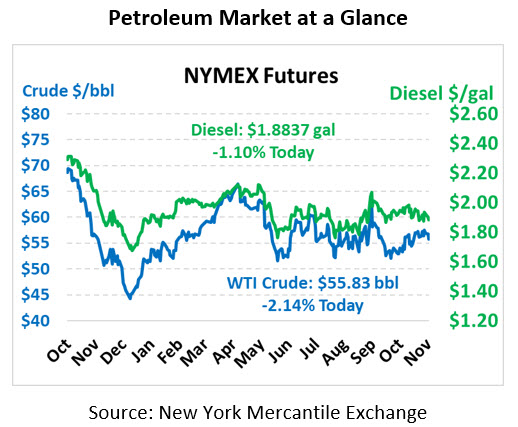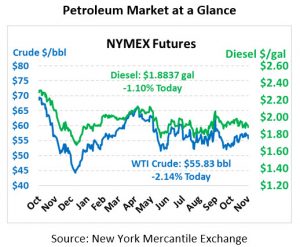
US Deemed a Net Oil Exporter
Crude is down on negative trade sentiment. Crude prices continue to be lower this morning following negative sentiment out of China surrounding Trump’s comment that there was no agreement on phasing out tariffs. A Chinese government source was quoted by CNBC as saying there was “gloom” in Beijing about prospects for a trade compromise. Crude is currently trading at $55.83, a loss of $1.22.
Fuel prices are down in line with crude. Diesel is trading at $1.8837, down 2.1 cents. Gasoline is trading at $1.6062, a loss of 1.5 cents.
The EIA estimates that the United States exported 140 kbpd more total crude oil and petroleum products in September than it imported; total exports exceeded imports by 550 kbpd in October. If confirmed, this would be the first time the United States exported more petroleum than it imported since EIA records began in 1949. EIA expects total crude oil and petroleum net exports to average 750 kbpd in 2020, a hefty swing from the 520 kbpd average net imports in 2019.
So, what does this mean? While we exported more petroleum products than we imported, the US is still reliant on global crude pricing; in fact, the rise in exports has increased our reliance on global markets. The lifting of the crude export ban in 2015 allowed American crude producers to begin sending oil overseas, meaning local consumers had to compete with global consumers for supply. While the rise of US production has tempered global oil prices, it’s also caused Brent-WTI spreads, the difference between global Brent prices and US WTI prices, to shrink, adding roughly $5/bbl (12 cents per gallon) in crude oil costs for US consumers.
Going forward, the rise of global oil trade will continue to keep US prices beholden to international fluctuations. When Saudi Arabia suffered a massive oil production attack in September, WTI prices rose almost as quickly as Brent crude. As long as we continue participating in oil markets, we’ll never be “free” of foreign oil. However, rising US production has also dampened OPEC’s ability to lift prices significantly, keeping prices in the $50-$60 range instead of the $80+ range. The rise of American production and exports is good for the US and good for the world – even if it doesn’t free us from global price volatility.
This article is part of Crude
MARKET CONDITION REPORT - DISCLAIMER
The information contained herein is derived from sources believed to be reliable; however, this information is not guaranteed as to its accuracy or completeness. Furthermore, no responsibility is assumed for use of this material and no express or implied warranties or guarantees are made. This material and any view or comment expressed herein are provided for informational purposes only and should not be construed in any way as an inducement or recommendation to buy or sell products, commodity futures or options contracts.






